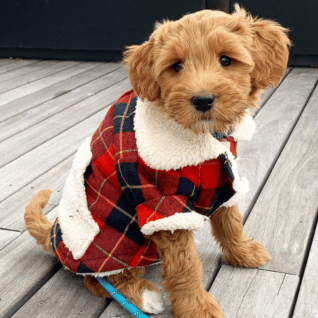Life tends to throw us a lot of curveballs and, unlike our canine companions, we may not be great at “catching” them every time. The point being, our lives can be pretty chaotic sometimes. When facing adding another thing to your ‘to-do’ list like brushing your dog, it may be one of the items that linger on the back burner. While it can be tempting to ignore brushing your dog, we’re here to give you 5 reasons you should brush your dog (or 5 reasons why you shouldn’t put it off):

@danishaussieadventure
5 Reasons You Should Brush Your Dog
@danishaussieadventure

@lila.loves.it
It helps put your dog at ease
Brushing your dog may help him or her stay comfortable. If your dog leans on the stubborn side and is usually not a fan, try introducing the behavior slowly, and rewarding them after being brushed. Matted hair can be painful if not attended and can be a source of overheating. Avoid the anxiety for you both and try to brush them once a week. It is also a great bonding activity for you and your pup, or it can be. The key is to teach them to enjoy the grooming process, so it can be a pleasant experience for you both.
Keeps Them Lookin’ Fresh
Okay, it may not seem like this matters to your dog, but a well-groomed dog looks healthier and happier than one that isn’t. If your dog’s hair looks closer to a ‘bad hair day,’ they may not be attended to, and it can be a sign of neglect. Don’t get us wrong, your dog doesn’t have to be dog show ready to have a good life, but your dog deserves to have a clean coat free from painful mats. They’ll feel better for it!

@britandbellecavapoochons

@callie_thetigerdog
Gets Rid of Dead Hair
Don’t you love all that dead hair that ends up on your furniture? Oh, and all of your black clothing, and your countertops, and…you get the point. It goes without saying, but brushing will eliminate the amount of dead hair that’s floating around your home. Your dog might not notice but you certainly will!
Regular Check-Up
When you take the extra time with your furry friend, you may catch things that you may not notice otherwise. For instance, when brushing them, you may see skin concerns, irritations, or even bumps. Harmless or not, early detection of these concerns can make all the difference. Staying on top of regular brushing can keep you one step ahead in managing your pup’s health.

@dogtorkristi

@theressomethingaboutperry
Glow Up That Coat
Brushing can help spread canines’ natural oils and make their coat shine by removing dead skin and stimulating the surface of your pet’s skin. It also prevents any grease buildup. Brushing is key to creating and maintaining your dog’s healthy coat.
How To Brush Your Dog Correctly
Brushing a dog is pretty straightforward. You will want to take your brush to your dog’s hair and go down and out. Pushing backward on a dog’s coat may be uncomfortable for your pet.
Try to be gentle and be mindful of matted hair as you will want to avoid causing discomfort. This may cause your dog to dart when seeing a brush if they associate it with a negative experience. Make sure you brush your dog when you have ample time. Should you experience some matted hair, invest in some products like a detangler spray to help loosen up hair, and do this BEFORE a bath, as water only makes matted hair worse.
What Type of Brush Do I Need?
There are many different dog products out there, and it can be pretty overwhelming on what brush will work with your pet’s coat. We’ll break it down by the length of coat:

@anutarostovskaia
Dogs With Short Hair
For dogs with short and smooth hair, such as a Beagle, we recommend a brushing frequency of once a week. For dogs such as terriers who have a bit of a thicker coat, we recommend brushing at least twice a week.
A rubber brush is going to be the gold standard. However, you may want to consider a grooming glove for convenience or a natural bristle brush if you notice your pet’s coat is a little stubborn.
Dogs With Double-Coats
For dogs that have an undercoat and a topcoat, such as an Australian Shepherd, Siberian Husky, or even a Pug, we recommend brushing at least twice a week.
These types of dogs tend to shed their undercoat seasonally while their topcoat remains year-round. Some tools to consider would be an undercoat rake, comb, or a pin brush.

@laylathebrownhusky

@diesel_minnie
Dogs With Silky Coats
For dogs with long silky hair and no overcoat, like an Afghan Hound or Silky Terrier, we would recommend brushing 3-4 times a week.
These dogs have a coat that continuously grows and requires grooming in-between visits to the groomer for haircuts. These dogs follow similar tool guidelines as the double-coated dogs with a comb or a pin brush.
Dogs With Curly-Coats
For dogs with curly hair, either soft or coarse (such as a poodle), we recommend brushing twice a week.
Canines with curly coats generally need upkeep to avoid their hair from being matted. Every other day, consider trying a slicker brush, comb, or a dematter tool.

@lunadoodlee

@lucythewirehairedachshund
Dogs With Wiry Hair
For dogs like a Jack Russell or dogs with thick and coarse wiry hair a good brushing at least twice a week.
Dogs with wiry hair coats require trimming and have an undercoat that will need addressing on a weekly basis. Brushing with a slick brush or comb will be your best friends in combating hair to prevent mats and keep these little pups looking fresh!
Do you have any tips or tricks for brushing your dog‘s hair? Share your stories below!




Conversation